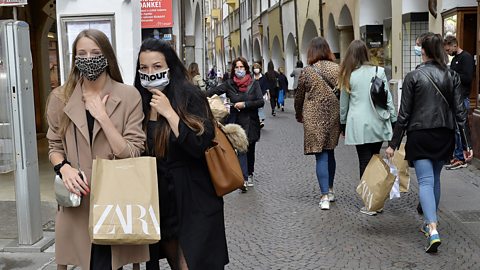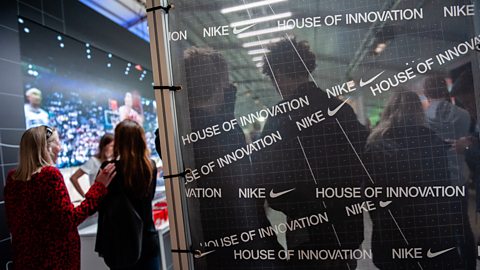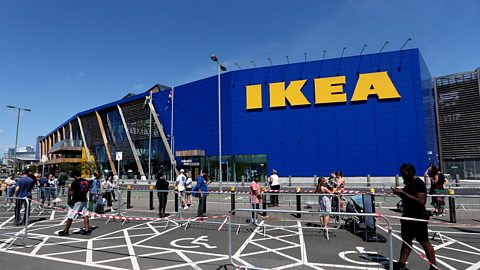By Simon LoweFeatures correspondent
 Getty Images
Getty ImagesTaking our time in shops will be difficult in a post-Covid-19 world. Are we still going to browse, and what does it mean if we don’t?
Henry Layte, owner of The Book Hive, one of the UK’s most renowned independent bookstores, thought long and hard about how to open again after lockdown. He considered wrapping each book in plastic, placing them on tables under Perspex or allowing a maximum of two people in at a time. But none of it felt right.
Instead, he will be using the shop’s rather grand, full-length windows that curve around a pedestrianised street in Norwich to display as many books as possible. He’ll show the front cover and the back blurb, enabling customers to browse from outside the store.
“We’re kind of open but you can’t come in,” says Layte. “When you get into the shop it’s quite long and narrow, and there’s just no way you can do it. The thing with browsing is you see a book, and you want to pick it up and read it. That’s just not possible in the current situation. We’ve got to try something new.”
Customers will still be able to buy books, place orders and ask for recommendations – but it’ll be through the window. Layte’s plan enables both his customers and staff to stay safe while retaining all the pleasure of browsing in a bookshop. It brings a whole new meaning to the phrase ‘window shopping’.
But even though The Book Hive and stores like it have found a way to enable customers to browse at least a little in the wake of Covid-19, will they even want to? If the pleasure of browsing is in looking, touching and, often, walking out intentionally empty handed, then a substitute for browsing in a pre-coronavirus world may not pass muster.
In that case, have we reached the end of browsing as we know it?

 Getty Images
Getty ImagesThe basis of browsing
We’ve all browsed at some point, looping through a shop to look around “without a current intent to buy”. According to Lan Xia, professor of marketing at Bentley University in Massachusetts, people browse for two reasons: to gather information (like learning about a product or category in person) or for pleasure. Research performed at Louisiana State University says that visiting stores to gain knowledge, such as sale prices or about different brands, can bring its own pleasure. But other research tells us window shopping also offers the benefits of escape, socialisation and simple fun.
The physical nature of in-store shopping plays a big part in our desire to browse. A survey by Retail Dive showed that shoppers much preferred the ability to see, touch, feel and try out items over shopping online. New York-based consumer psychologist Peter Noel Murray believes this type of browsing can give us a positive psychological boost. “By sitting in a luxury car at the car dealership, we are vicariously experiencing the emotion of owning a luxury car, which means browsing in and of itself can be a rewarding experience,” he says.
And although many browsers walk out of stores without buying anything, that’s not always the case. “Browsing offers the opportunity of serendipity,” says Xia. “One thing leads to another and you end up with something you hadn’t thought of buying in the first place.”

 Getty Images
Getty ImagesThis means browsing actually drives quite a bit of revenue for stores; a 2019 report from online merchandising company First Insight found that during a typical shopping visit consumers spend more in store than they do online. Its survey of more than 1,000 US shoppers found that 54% of consumers spend upwards of $50 (£39) online – but that rises to 71% when shopping in stores.
The same report also showed a stark increase in impulse buying when shopping in a physical store. Ian Zimmerman, assistant professor at the University of Minnesota, Duluth, says that “experiencing pleasure at the thought of owning a product we see while browsing can make us more impulsive, because that emotional response can short-circuit rational thinking”.
A compelling experience
Xia’s research shows that people browse both because they want to as consumers, but also because certain retail environments encourage them to do so. Her findings suggest factors such as store layouts, levels of crowding and exposure to colours and smell “offer a higher level of stimulation in order to enhance recreational browsing”.
Chuck Palmer, senior advisor at Ohio-based retail consultancy ConsumerX Retail, agrees. He says that before the pandemic many brands and retailers were adding large, experiential stores to their portfolios, designed specifically with the recreational shopper in mind.

 Getty Images
Getty ImagesAn example is Nike’s House of Innovation stores in New York, Shanghai and Paris. Rather than focusing on functionality or convenience, the consumer is treated to a sensory experience using huge digital displays and modern design. “So, when the average sports shopper goes into one of those Nike stores, they’re engaged,” says Palmer. “They think, ‘Wow, they do this for me!’”
But with shopping restrictions now in place as a result of Covid-19 – things like social distancing, closed changing rooms, intense cleaning procedures, quarantining goods, the inability for multiple customers to touch the same things consecutively – the future of these experiential spaces geared toward browsing could be in jeopardy. As Xia says, “with all these restrictions, consumers are going to need a really good reason to go to the mall. People will start to find other venues to fill that social connection.”
Yet browsing may play a deeper role in our lives than we might think; it can also help shape how we define ourselves. In his paper, Recreational Shopper Identity, Michael Guiry, an associate professor at West Chester University of Pennsylvania, suggests some of us “assume a recreational shopper identity as part of our self-concept”. In other words, browsing forms an aspect of our personality. Guiry’s study showed that people were fantasising as they browsed – like playing a kind of make-believe. And for some recreational shopping enthusiasts, browsing is a “central facet of life… that transcends enjoyment and other dimensions of leisure”.

 Getty Images
Getty ImagesA transition to online – or a decline?
If the drive for browsing is still there among shoppers, however, consumers may opt to window-shop online instead. In fact, some research shows that online window shopping (or ‘e-browsing’) can provide a similar jolt of social and hedonic experience as well as offer the kind of information many seek out in person.
But even some of the ways in which consumers are used to browsing online are intimately tied to the store experience. They often combine the ability to shop online with visiting a store, commonly known as webrooming and showrooming. The former is when consumers browse products online before visiting a store to purchase, whereas showrooming works in reverse, where consumers browse physical stores before purchasing online.
It’s possible, then, that browsing on the whole may take a major hit without bricks-and-mortar shops – especially amid the pandemic. Unlike in-store shopping, online shopping is more streamlined to get consumers to the checkout quickly. “Many big retailers are multi-channel,” says Xia. “You can shop in store, online, delivered to your home, delivered to the store, all of which takes care of the functional shopper. People have less of a motivation to go into the physical store and browse nowadays.”

 Getty Images
Getty ImagesAnd people are poised to keep shopping online, even as shops open their doors again. A recent UK survey showed that two in five people intend to carry on purchasing goods online rather than return to stores when they re-open.
With such a shift in purchasing behaviour, it may not even be that physical retail doesn’t satisfy the recreational consumer any longer, but rather that there’s simply no room for the act of browsing in the post-Covid shopping world.
Getting creative
Creativity could be key for shops that want to keep browsing customers engaged and, accordingly, customers may need to get creative in how they perceive that window-shopping experience.
At The Book Hive, Layte is hoping he can keep the spirit of browsing alive – even if he can’t quite bring things back to how they were before the coronavirus. The store has been selling ‘isolation packs’: customers give examples of a book they love and a book they hate, then Layte and his team of expert booksellers choose an appropriate title and post it to the customer without revealing their choice in advance.
It may not be the same as browsing, but it reintroduces fun, adventure and discovery into the shopping experience – especially when the landscape of any kind of shopping has been so dramatically altered. But perhaps the element of surprise in his isolation packs – what Layte calls “a gamble” – is enough exhilaration to fill any void the loss of traditional browsing has left behind.
Credit: Source link



